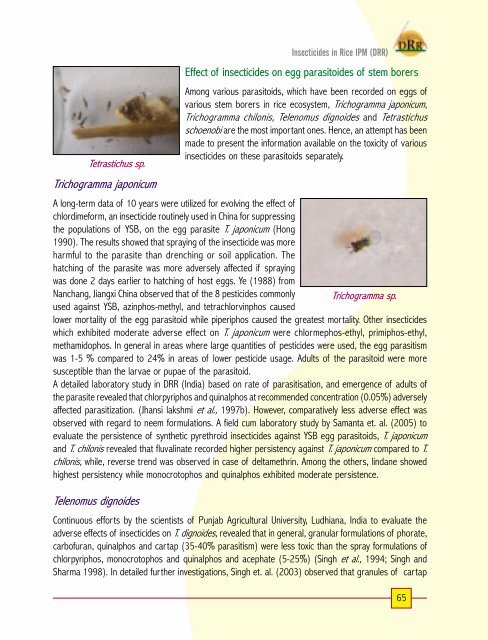priciples of insecticide use in rice ipm
priciples of insecticide use in rice ipm
priciples of insecticide use in rice ipm
Create successful ePaper yourself
Turn your PDF publications into a flip-book with our unique Google optimized e-Paper software.
Tetrastichus sp.<br />
Trichogramma japonicum<br />
Insecticides <strong>in</strong> Rice IPM (DRR)<br />
Effect <strong>of</strong> <strong><strong>in</strong>secticide</strong>s on egg parasitoides <strong>of</strong> stem borers<br />
Among various parasitoids, which have been recorded on eggs <strong>of</strong><br />
various stem borers <strong>in</strong> <strong>rice</strong> ecosystem, Trichogramma japonicum,<br />
Trichogramma chilonis, Telenomus dignoides and Tetrastichus<br />
schoenobi are the most important ones. Hence, an attempt has been<br />
made to present the <strong>in</strong>formation available on the toxicity <strong>of</strong> various<br />
<strong><strong>in</strong>secticide</strong>s on these parasitoids separately.<br />
A long-term data <strong>of</strong> 10 years were utilized for evolv<strong>in</strong>g the effect <strong>of</strong><br />
chlordimeform, an <strong><strong>in</strong>secticide</strong> rout<strong>in</strong>ely <strong>use</strong>d <strong>in</strong> Ch<strong>in</strong>a for suppress<strong>in</strong>g<br />
the populations <strong>of</strong> YSB, on the egg parasite T. japonicum (Hong<br />
1990). The results showed that spray<strong>in</strong>g <strong>of</strong> the <strong><strong>in</strong>secticide</strong> was more<br />
harmful to the parasite than drench<strong>in</strong>g or soil application. The<br />
hatch<strong>in</strong>g <strong>of</strong> the parasite was more adversely affected if spray<strong>in</strong>g<br />
was done 2 days earlier to hatch<strong>in</strong>g <strong>of</strong> host eggs. Ye (1988) from<br />
Nanchang, Jiangxi Ch<strong>in</strong>a observed that <strong>of</strong> the 8 pesticides commonly Trichogramma sp.<br />
<strong>use</strong>d aga<strong>in</strong>st YSB, az<strong>in</strong>phos-methyl, and tetrachlorv<strong>in</strong>phos ca<strong>use</strong>d<br />
lower mortality <strong>of</strong> the egg parasitoid while piperiphos ca<strong>use</strong>d the greatest mortality. Other <strong><strong>in</strong>secticide</strong>s<br />
which exhibited moderate adverse effect on T. japonicum were chlormephos-ethyl, primiphos-ethyl,<br />
methamidophos. In general <strong>in</strong> areas where large quantities <strong>of</strong> pesticides were <strong>use</strong>d, the egg parasitism<br />
was 1-5 % compared to 24% <strong>in</strong> areas <strong>of</strong> lower pesticide usage. Adults <strong>of</strong> the parasitoid were more<br />
susceptible than the larvae or pupae <strong>of</strong> the parasitoid.<br />
A detailed laboratory study <strong>in</strong> DRR (India) based on rate <strong>of</strong> parasitisation, and emergence <strong>of</strong> adults <strong>of</strong><br />
the parasite revealed that chlorpyriphos and qu<strong>in</strong>alphos at recommended concentration (0.05%) adversely<br />
affected parasitization. (Jhansi lakshmi et al., 1997b). However, comparatively less adverse effect was<br />
observed with regard to neem formulations. A field cum laboratory study by Samanta et. al. (2005) to<br />
evaluate the persistence <strong>of</strong> synthetic pyrethroid <strong><strong>in</strong>secticide</strong>s aga<strong>in</strong>st YSB egg parasitoids, T. japonicum<br />
and T. chilonis revealed that fluval<strong>in</strong>ate recorded higher persistency aga<strong>in</strong>st T. japonicum compared to T.<br />
chilonis, while, reverse trend was observed <strong>in</strong> case <strong>of</strong> deltamethr<strong>in</strong>. Among the others, l<strong>in</strong>dane showed<br />
highest persistency while monocrotophos and qu<strong>in</strong>alphos exhibited moderate persistence.<br />
Telenomus dignoides<br />
Cont<strong>in</strong>uous efforts by the scientists <strong>of</strong> Punjab Agricultural University, Ludhiana, India to evaluate the<br />
adverse effects <strong>of</strong> <strong><strong>in</strong>secticide</strong>s on T. dignoides, revealed that <strong>in</strong> general, granular formulations <strong>of</strong> phorate,<br />
carb<strong>of</strong>uran, qu<strong>in</strong>alphos and cartap (35-40% parasitism) were less toxic than the spray formulations <strong>of</strong><br />
chlorpyriphos, monocrotophos and qu<strong>in</strong>alphos and acephate (5-25%) (S<strong>in</strong>gh et al., 1994; S<strong>in</strong>gh and<br />
Sharma 1998). In detailed further <strong>in</strong>vestigations, S<strong>in</strong>gh et. al. (2003) observed that granules <strong>of</strong> cartap<br />
65











